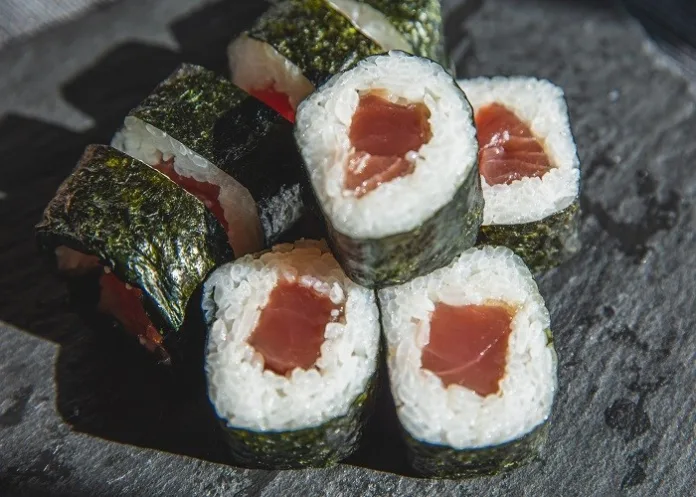Following a Japanese diet of seaweed, soy foods and seafood, can help slow the progression of non-alcoholic fatty liver disease (NAFLD) in people with the condition, according to a recent study, which found these foods were most strongly associated with slowing the progression of liver fibrosis.
The authors of the study tracked the diet and disease progression of 136 people with NAFLD being treated at the Osaka Metropolitan University Hospital in Japan, scoring each person’s diet according to adherence to the 12-component Japanese Diet Index, or mJDI12.
High mJDI12 scores were associated with a slowing of the progression of liver fibrosis that accompanies NAFLD.
The Japanese diet consists of 12 foods and food groups:
1. rice
2. miso soup
3. pickles
4. soy products
5. green and yellow vegetables
6. fruits
7. seafood
8. mushrooms
9. seaweed
10. green tea
11. coffee
12. beef and pork
Within the Japanese diet, people who consumed more soy, seafood and seaweed enjoyed the most significant suppression of liver fibrosis progression.
The researchers also tracked the effect of the diet on muscle mass and found that people who ate more soy products built a greater amount, in addition to having low rates of fibrosis progression.
The study was published in MDPI.
Unpacking NAFLD
NAFLD is a largely symptomless condition in which fat builds up in the liver, potentially affecting the function of the organ, although it does not directly damage it.
With NAFLD, a person is at higher risk of non-liver malignancies such as colorectal cancer, chronic kidney disease, gastro-oesophageal reflux, obstructive sleep apnea, hypothyroidism, periodontitis, polycystic ovarian syndrome, and psychological and growth hormone problems.:
“Consuming excess fat, particularly saturated fat, along with processed carbohydrates – fructose, glucose, and sucrose – and too many calories, lead to an imbalance between fat accumulation and breakdown in the liver, with fat build-up in the liver being the consequence,” Dr Muhammad Nadeem Aslam, assistant research scientist in the Department of Pathology at the University of Michigan, who was not involved in the study, told Medical News Today.
Examples of NAFLD-promoting foods include hydrogenated oils, fried foods, juices, soda, and processed foods.
The three most influential foods cited in the study have their own benefits, and share at least one attribute: they are all low-fat.
“Soybeans, for instance, are rich in fibre plant proteins that are low in saturated fat,” said Aslam. And seafood contains anti-inflammatory and antioxidant properties, aiding the potentially suppressive effect on fibrosis progression.
“Japanese seaweed is rich in polyphenols, vitamins, and minerals. Most edible algae contain a unique set of nutrients,” he said, adding that antioxidant-rich coffee beans are also associated with an overall lower risk for NAFLD.
And raspberries “are rich in insoluble fibre that helps create a short chain fatty acid in the gut called butyrate, which studies have shown to be helpful in the reversal and prevention of fatty liver disease”.
Study details
Severity of Liver Fibrosis Is Associated with the Japanese Diet Pattern and Skeletal Muscle Mass in Patients with Nonalcoholic Fatty Liver Disease
Yoshinari Matsumoto, Hideki Fujii, Norifumi Kawada, et al.
Published in MDPI on 26 February 2023
Abstract
It is not fully clear as to which dietary patterns are associated with the pathogenesis of nonalcoholic fatty liver disease (NAFLD) in Asia. We conducted a cross-sectional study of 136 consecutively recruited patients with NAFLD (49% female, median age 60 years). Severity of liver fibrosis was assessed using the Agile 3+ score, a recently proposed system based on vibration-controlled transient elastography. Dietary status was assessed using the 12-component modified Japanese diet pattern index (mJDI12). Skeletal muscle mass was assessed by bioelectrical impedance. Factors associated with intermediate–high-risk Agile 3+ scores and skeletal muscle mass (75th percentile or higher) were analysed by multivariable logistic regression. After adjustment for confounders, such as age and sex, the mJDI12 (OR: 0.77; 95% CI: 0.61, 0.99) and skeletal muscle mass (75th percentile or higher) (OR: 0.23; 95% CI: 0.07, 0.77) were significantly associated with intermediate–high-risk Agile 3+ scores. Soybeans and soybean foods were significantly associated with skeletal muscle mass (75th percentile or higher) (OR: 1.02; 95% CI: 1.00, 1.04). In conclusion, the Japanese diet pattern was associated with the severity of liver fibrosis in Japanese patients with NAFLD. Skeletal muscle mass was also associated with the severity of liver fibrosis, and intake of soybeans and soybean foods.
See more from MedicalBrief archives:
Coffee a powerful addition to NAFLD treatment arsenal — Meta-analysis
NAFLD and cardiovascular risk – American Heart Association scientific statement
Post-menopausal women at higher risk of NAFLD — research review
Bariatric surgery significantly cuts cancer risk in severely obese NAFLD patients

